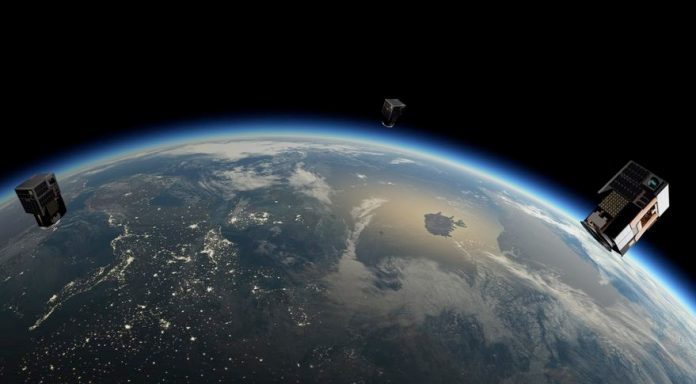
WASHINGTON — Earth imaging company Satellogic announced July 6 it will go public through a merger with a special purpose acquisition company (SPAC), raising the funding it needs to build out a constellation of 300 spacecraft.
Satellogic said it will merge with CF Acquisition Corp. V, a SPAC sponsored by financial firm Cantor Fitzgerald. The SPAC holds $250 million in cash after going public on the Nasdaq exchange in February, and an additional $100 million will come from a current funding round known as private investment in public equity.
After debt repayment and expenses, Satellogic expects to have $271 million in cash when the deal closes, which the companies expect to be early in the fourth quarter. The merger will give Satellogic a valuation of $1.1 billion.
Satellogic, headquartered in Montevideo, Uruguay, but with offices in several countries, currently operates 13 imaging satellites that provide high-resolution and hyperspectral imagery. The company launched four more satellites on SpaceX’s Transporter-2 dedicated rideshare mission June 30 that will be operational in six to eight weeks.
The funds from the SPAC deal will allow Satellogic to build out its constellation. In an interview, Emiliano Kargieman, chief executive and co-founder of Satellogic, said that he expected the money would “get us to a 300-satellite constellation by 2025.”
Getting to that full constellation will require investments in satellite production facilities. The company’s satellites have been built in a “pilot plant” it has in Uruguay, but Kargieman said Satellogic is scouting several locations in Europe to build a new facility that will produce satellites at a much higher rate.
“We expect to hit 60 satellites operating in orbit by the beginning of 2023. That will give us the ability to remap at 70 centimeters resolution of any point on the planet every week,” he said. “And from there, we will continue to grow at roughly 100 satellites per year to get to a 300-satellite constellation by 2025. So, the high-throughput manufacturing facility we’re putting together will allow us to roll out 100 satellites per year.”
The company sought to raise the funding now upon reaching what he called an “inflection point” after demonstrating the capability of the satellites as well as the business cases and economics of their imagery. “Now it’s the time to grow and scale, and really deliver on our vision.”
Satellogic had raised modest amounts of funding privately, including a $50 million round in December 2019, but Kargieman said the company decided early this year to explore a SPAC deal. “We saw the opportunity of taking the company public as a way to tap into a source of financing to allow us to grow the constellation,” he said. “The SPAC has given us the opportunity to do that because it’s a vehicle that’s really well adapted to early-stage companies.” He said Satellogic selected a SPAC sponsored by Cantor Fitzgerald because of that company’s background in the financial world, including its sponsorship of several SPACs.
In an investor webinar published by Satellogic July 6, Howard Lutnick, chairman and CEO of Cantor Fitzgerald, praised the “extraordinary opportunity” that he said Satellogic offered through its vision of low-cost, frequent high-resolution imagery. “This makes for a fundamentally different and better business model,” he said.
In that webinar, Satellogic argued that it can provide imagery at a cost per square kilometer roughly 100 times cheaper than competitors such as Airbus, BlackSky, Maxar and Planet. The design of the spacecraft allows it to collect 10 times as much imagery, the company said, while its vertically integrated production model produces satellites at one-tenth the cost.
The company’s financial projections see revenue growing from $7 million in 2021 to $787 million in 2025, starting with defense and intelligence customers followed by commercial customers. It projects reaching positive free cash flow in 2024, as both revenues increase and capital expenditure growth levels off.
A key test will be its ability to generate revenue growth. The company projects a total addressable market in various fields of $140 billion, with $2.1 billion in business opportunities in the near and longer term. However, its current backlog is only $38 million.
“This is the chicken-and-egg problem for this industry,” Kargieman said in the interview: customers want low-cost data that requires a large constellation, but the company needs to know what kind of data customers want before building that large constellation. Satellogic has tried to solve that problem with a series of pilot programs with customers in 12 different markets involving both actual satellite data and simulated data.
“It’s allowed us to validate a total addressable market for us when we reach weekly remaps” in 2023, which he estimates at $40 billion. “That’s given us the confidence to go and make the capex investments that we need to build out this constellation.”
In the webinar, Kargieman said that, based on the sheer size of the constellation and its imaging capabilities, Satellogic could have, when the full constellation of 300 satellites is in operation, control of more than 85% of the global supply of high-resolution satellite imagery. “This is a winner-takes-most or winner-takes-all market where we’re uniquely positioned to win.”
– Advertisement –